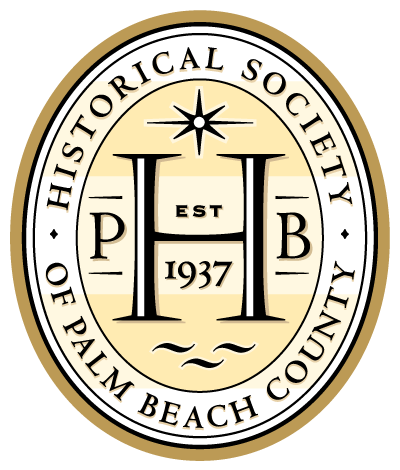Post-World War II to Present
FLORIDA’S POPULATION
After World War II, the population of Florida and Palm Beach County grew quickly. Many of the soldiers stationed here during World War II saw Florida as a land of opportunity and moved here after the war. As a result, Florida experienced a second land boom, which started in the 1950s and has not stopped. There have been, however, several periods when the economy slowed down but recovered a few years later. The most recent slowdown was in 2007, when the real estate and banking industries crashed.
The state population nearly doubled from 1950 (2,771,305) to 1960 (4,951,560). The rise in population required more industry, agriculture, recreation, and housing. Every ten years, Florida becomes home to at least two million more people. Such growth requires additional resources.
As more people move to Florida, the population becomes more diverse, which means a variety of people who have different languages and cultures. Europeans, Asians, West Indians, and Hispanics have become a large part of our population. Since World War II, Florida has also become home to a large number of immigrants from Cuba and Haiti.
In 2014 the U.S. Census Bureau reported that Florida was the third most populated state, having surpassed New York, and it still was in 2021. Only California and Texas had more residents. The population figure—over twenty million—does not include snowbirds, people who live in Florida only during the warm winter months.
PALM BEACH COUNTY’S DIVERSE POPULATION
During the 1870s and 1880s, some of the pioneers who came to the Lake Worth region seeking a better life were African Americans, or Blacks. In the 1890s, many people came to work on Henry Flagler’s railroad and hotels. When he established West Palm Beach, it attracted more people looking for good jobs and better housing. Among those following Flagler were European immigrants and Blacks.
In the early twentieth century, Japanese settlers were enticed by Flagler’s Model Land Company to establish an agricultural community. This colony, Yamato, was located between Delray Beach and Boca Raton.
Hispanics have been making their homes here for at least a hundred years and are the county’s fastest growing population. But it was not until after World War II that the permanent population of Palm Beach County exploded. People came to the area from all around the globe, and continue to do so today.
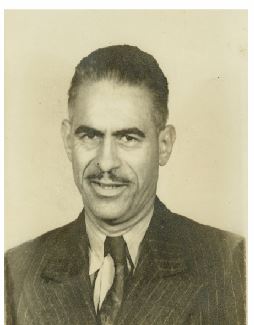
AFRICAN AMERICANS
By the late nineteenth century, a small population of African Americans, or Blacks, lived on Lake Worth. When Henry Flagler started building in Palm Beach, people of many races came to work in the hotels and on the railroad. One of the earliest communities for the workers was in Palm Beach, an African American community called the Styx. The name comes from Greek mythology, where the River Styx leads to the underworld.
In Palm Beach, from the early 1890s to about 1910, the Styx was home for many of Flagler’s workers. Several white men owned parts of the land occupied by the Styx, although a local legend claimed that Flagler owned it. In the early twentieth century, brothers Edward and John Bradley bought the land to develop. Because the residents were tenants who paid rent and did not own the land, they had to move. Many of them bought land and built homes in the Northwest District, Freshwater District, and Pleasant City neighborhoods of West Palm Beach across the bridge.
While Blacks worked on the railroad and helped build hotels, some ran their own businesses. One such man was Haley Mickens, who ran a wheelchair business in Palm Beach. Mickens also helped to found the Payne Chapel A.M.E. Church, which is now located in West Palm Beach.
Blacks also lived in other communities in Palm Beach County. Will Melton and the Gildersleeve family settled in Riviera Beach in the 1880s and 1890s. Also in the 1890s, Black farmers settled in what became Boynton Beach. Some of Delray Beach’s settlers came to work on Flagler’s railroad as it moved south. They settled in neighborhoods known as Green’s Corner, Hannah Town, and Davis Town, early Black communities near today’s Atlantic Avenue.
In the 1920s, wealthy Blacks lived in the Freshwater District of West Palm Beach in homes mostly built by local Black contractors. Hazel Augustus, thought to be West Palm Beach’s first Black architect, designed many of the houses and churches in the Freshwater District, including his own home at 615 Division Street.
Black professionals came to West Palm Beach to set up businesses. Some were doctors, dentists, and pharmacists. Dr. Thomas LeRoy Jefferson was the city’s first Black medical doctor. Dr. Warren Hale Collie, a veteran of World War I, was one of the first Black dentists to practice in Palm Beach County. In 1933, Dr. Joseph Wiley Jenkins moved to West Palm Beach, where he and his wife, Roberta, opened the Economical Drug Store at the corner of Fourth Street and Rosemary Avenue. Roberta designed their dream home on Virginia Avenue, which became Division Avenue. In 1996, the City of West Palm Beach bought this house and preserved it as the Artists Showcase of the Palm Beaches.
In 2016, Bradley G. Harper became the first Black to be elected as a county judge without first having been appointed by the governor. Judge Harper is a sixth-generation native of Palm Beach County and a great-great-great-grandson of Millie Gildersleeve. He graduated from Morehouse College and University of Florida College of Law. He founded the Blueprint Leadership Program and Boyz to Men Mentoring Program to expose children to the justice system and local history, and to train students to be leaders.
Throughout the years, Blacks have played important roles in the history and development of Palm Beach County. Many are prominent business owners who provide needed jobs and are involved in politics at the local, state, and national levels. Their history and continued contributions are important to the past, present, and future development of Palm Beach County and Florida.
F. MALCOLM CUNNINGHAM SR.
F. Malcolm Cunningham was a graduate of Florida A & M University and Howard University (Washington, DC), where he earned his law degree. In 1953 he became the second lawyer in West Palm Beach. Nine years later, Cunningham was the first Blacks to be elected to the Riviera Beach City Council. He was reelected twice before retiring from public office. Cunningham was also involved in the civil rights movement, fighting for equal rights for Blacks. He was a founding member of the Virgil Hawkins Florida Chapter of the National Bar Association. The F. Malcolm Cunningham Sr. Bar Association is named for him. His son F. Malcolm Cunningham Jr. followed in his father’s footsteps as an attorney.
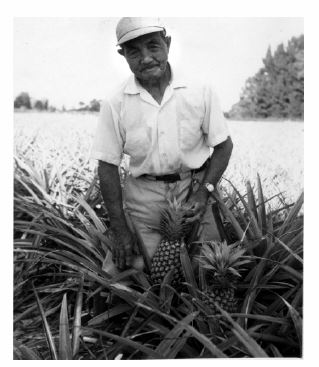
THE YAMATO COLONY
The Yamato Colony was an agricultural settlement of Japanese farmers introduced to north Boca Raton by Joseph Sakai, who worked for Flagler’s Model Land Company. They called their settlement Yamato, an ancient name for Japan meaning large peaceful country. At first, the colony focused on growing pineapples, because the farmers could sell the fruit for high prices. They also grew citrus and vegetables. Pineapple farming ended when the fruit was destroyed by disease, and cheaper pineapples from the Caribbean made it unprofitable to grow them in Florida.
By World War II, most of the Yamato colonists had returned to Japan or moved to other states. The colony ended when the few remaining farmers were forced to leave during World War II, because some of their land was needed for an army base. Yamato Road in Boca Raton is named in honor of this community of Japanese farmers.
HISPANICS OF PALM BEACH COUNTY
Hispanics are the fastest-growing part of the population, not only in Palm Beach County, but in the entire United States. Between 1980 and 2010, the number of Hispanics in the county grew from 28,505 to 250,832. Cubans, Puerto Ricans, and Mexicans are still in the majority, but immigrants from Central and South American countries are on the rise.
Large groups of Mexicans and Guatemalans live in Lake Worth. A large Guatemalan community also lives in Jupiter, speaking one of the many Mayan-language dialects. Puerto Ricans make up a large part of the Hispanic population in West Palm Beach and live in other communities throughout the county.
The Hispanic/Latin community is steadily making in-roads in all aspects of life in Palm Beach County. They own and operate businesses, and many work as lawyers, doctors, and in the service and agricultural industries.
In 1991, Nancy Perez was the first Hispanic American to be appointed a judge. As the twenty-first century progresses, Hispanics and Latinos will take other leading roles in the development of Palm Beach County.
THE FANJUL FAMILY
One of the largest sugar cane growers in Palm Beach County is the Fanjul family from Cuba. The island of Cuba was once a large supplier of sugar to the United States, until Fidel Castro took control of Cuba and established a communist government. Because the United States was against communism, it stopped buying sugar from Cuba. When the sugar cane farms owned by the Fanjuls were taken over by the Cuban government, the family moved to the United States. They started growing sugar cane on a few thousand acres in the Glades, and by 2000, were farming thousands of acres. Their company added rice as a rotation crop. The family has about 3,000 employees, owns several sugar mills, and owns companies in the Dominican Republic.
THE HAITIAN AMERICAN COMMUNITY
In small and large numbers, Haitian immigrants have come to Palm Beach County since before 1980, seeking a better life. Since 1980 there have been three waves of migration: (1) In 1986, at the end of the Duvalier regime in Haiti, many settled in Delray Beach, Boca Raton, and Boynton Beach. (2) In 1991, another mass migration took place. (3) After the devastating 2010 earthquake in Haiti, many more Haitians moved to Florida.
One subdivision in Delray Beach called Osceola Park has been the home of Haitian Americans since 1980. Delray Beach has the largest Haitian population in the United States. In 2013, it was estimated at 95,000.
Mack Bernard, born in Haiti, graduated from Florida State University and University of Florida College of Law. In 2008 he served as deputy vice-mayor and a city commissioner of Delray Beach. A year later he was elected to the Florida House of Representatives and served as president of the Palm Beach County Caucus of Black Elected Officials. In 2016 he became the first Black male and Haitian American elected to the Board of Palm Beach County Commissioners, serving as county mayor. Bernard, an attorney, is active in community organizations, including the Toussaint L’Ouverture High School for Arts & Social Justice and the Color of Hope Foundation. In just over thirty years, Haitians have become an integral part of the county’s cultural landscape.

JOSEPH BERNADEL
Joseph Bernadel joined the U.S. Army in 1975 after immigrating to the United States from Haiti. In 1997 he retired, after serving the country for twenty-two years. He speaks five languages: Creole, English, Portuguese, Spanish, and French. In 2001, he co-founded the Toussaint L’Ouverture High School for the Arts & Social Justice in Delray Beach. Bernadel is the first Haitian American in the U.S. to have founded a public school.
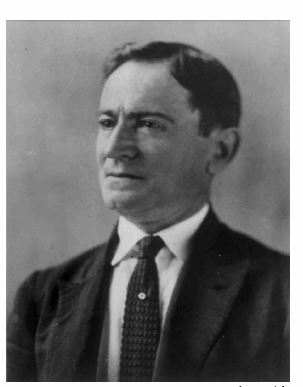
PALM BEACH COUNTY’S JEWISH HERITAGE
Jews have been settling in Florida since the late eighteenth century. For much of the early years, they lived in north Florida and Key West. When railroads opened up south Florida, they also moved there. The recorded history of Jews in Palm Beach County dates back to at least the early 1890s, when Henry Flagler began to develop the area. When the City of West Palm Beach was incorporated, businessmen of Jewish descent opened shops in the new town, selling everything from clothing to hardware.
Jews have made other contributions to the county. In West Palm Beach, the residents elected Joseph Mendel, the city’s first Jewish mayor, in 1923. Others have served in various leadership roles, including mayor and city and county commissioner. The Jewish community founded its own newspaper in the 1930s. Jews have helped many Palm Beach County communities. They have donated millions of dollars to support many cultural arts organizations and educational institutions and agencies providing help to the less fortunate.
The Jewish population in Palm Beach County remained small from the 1890s until after World War II. In 1940 the county’s Jewish residents numbered about a thousand in a very close-knit community. They often came together for social and religious events.
Following the war, there was a surge of Jewish migration to south Florida, primarily to Miami-Dade, Broward, and Palm Beach counties. By 1950, the Jewish population had grown to about 3,000 in Palm Beach County. Thirty years later, it had risen to 89,000. In 2018, there were 134,200 Jewish adults and children living in 69,000 households in Palm Beach County.
Jews are involved in every part of life and have added to the cultural diversity of Palm Beach County.
JOSEPH MENDEL
Joseph Mendel was born in Albany, New York, on November 17, 1866. His doctor recommended that he live in a better climate for his health, so in 1908 he moved to Florida. In 1923, he was elected to the West Palm Beach City Commission, which eventually appointed him as mayor. With this appointment, Mendel became the first Jewish mayor of West Palm Beach. After his public service, Mendel earned his living in banking and real estate.
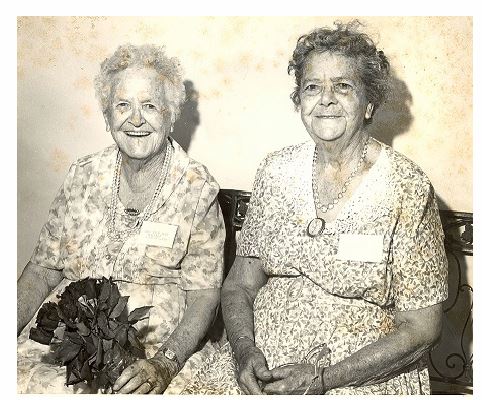
PIONEERING WOMEN OF PALM BEACH COUNTY
Women as well as men helped to shape Palm Beach County. A few of the pioneering women were Lillie Pierce Voss, Susan Sanders DuBois, Eva Williams Mack, Nancy Perez, and Catherine Link Strong.
In 1876, H. D. Pierce’s daughter, Lillie, was born at the Orange Grove House of Refuge. She lived in the south end of the county all her life. Her mother taught her to read and write, but she admitted that no one could teach her “figures” (math). Lillie grew up as a tomboy. As an adult, she wore a pistol on her hip so she could shoot rattlesnakes on her property. One day in the 1920s, the sheriff warned Lillie to stay inside because the Ashley Gang— known for robbing banks and trains—was rumored to be in the area. That didn’t scare Lillie Pierce Voss. She grabbed her shotgun and sat in a chair in the middle of the road, determined to protect her property.
Susan Sanders came to Florida in 1897 at the age of twenty-one to be a teacher. Her first assignment was west of Stuart, where school was held in an 8-by-10-foot palm-thatched hut. It had a dirt floor and benches along the sides for the students. Sanders was paid $40 per month, from which she paid $10 per month for room and board while living with a family of seven and two male boarders. The house had only one room, with a bed in each corner and one in the middle. Sanders shared a bed with the family’s daughter. The daughter and mother shared a pair of shoes, while the men in the family went barefoot. Most important though, the children received an education.
The School Board eventually transferred Sanders to the school in Jupiter, where she met John DuBois. After they were married, Susan used her salary to buy a cow, a dozen hens, and an old rooster. Her husband built them a three-room house atop the shell midden that Jonathan Dickinson had visited when he was shipwrecked in the 1690s. The house is still there and is open to the public. The DuBoises cleared land for a large garden and grew pineapples as a cash crop. They had several children, so they had to add on to the house. Susan said they never went hungry because she always had eggs, fresh vegetables from her garden, and fish.
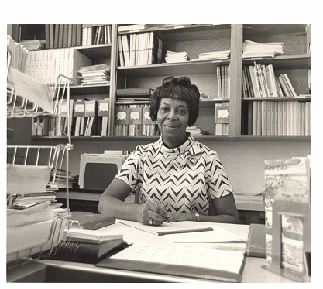
Eva Williams Mack was born in Alabama in 1915. She earned a nursing degree at Simmons College in Boston, trained in Atlanta, and earned bachelor’s and master’s degrees from Columbia University. After completing her education, Mack moved to West Palm Beach in 1948 and worked as a public health nurse with Dr. Carl Brumback, Palm Beach County’s first public health director. Mack was the first health specialist for the Palm Beach County School Board, and founded the Sickle Cell Disease Foundation of Palm Beach County in 1979. A year earlier, she and Ruby Bullock became the first African American city commissioners of West Palm Beach. Mack the first Black to be elected mayor of West Palm Beach, in 1982, and served two terms of one year each.
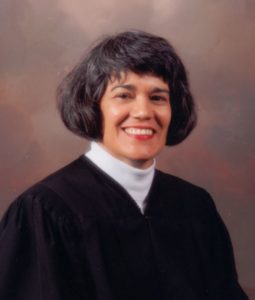
Nancy Perez was one of eleven children of Puerto Rican migrant farm workers. She was born near Buffalo, New York, because her mother was employed picking strawberries and cherries there at the time. Nancy started work picking tomatoes in New Jersey at the age of eleven. Then her father decided his children could move beyond migrant farming with education, and relocated the family to the Fort Myers area of Florida. The children no longer missed school to pick crops. Most of them graduated from high school, and four earned college degrees.
With an excellent academic record, Nancy received scholarships that put her through Edison Community College and Florida State University, where she received a bachelor’s degree in business and accounting. She went on to law school in part, she said later, to improve the treatment of migrant workers that she had seen first-hand. Perez worked for the Migrant Farm Workers Division of Georgia Legal Services before becoming a supervisor for the Association of Migrant Associations in Tallahassee. After passing the Florida Bar in 1983, Perez worked as an assistant public defender in West Palm Beach. She began serving as a judge in 1991, becoming the first Hispanic American judge in Palm Beach County.
Catherine Strong was born Catherine Elizabeth Link in New York and moved to Delray Beach with her family about 1920, when her father worked as a craftsman for Mizner Industries. In 1923, he became general contractor for the Del-Ida Park subdivision and built the family home there, at N.E. Second Avenue and Dixie Boulevard. When she was sixteen, Catherine played trombone in the Women’s Business Band. She married Milton J. “Jack” Strong in 1939.
Strong was the first woman in Palm Beach County to be called for jury duty, in January 1950. She started as a clerk at Delray Beach City Hall and was elected to the city commission three times from 1953 to 1957, moving officials to change the title city councilman to city commissioner to resolve the gender issue. After she was elected mayor in 1954, she initiated the recruitment of light industry to Delray. In these roles, Strong was consistently a minority voice helping the Black community receive fair treatment; in 1956 she successfully fought an attempt to change the city limits aimed at eliminating all Black neighborhoods. Catherine Strong was honored with her name in three places: a wing at Bethesda Memorial Hospital, where she had served on the founding board; a community center in Delray Beach; and a fountain at Delray Beach Memorial Gardens.
These pioneering women made a difference in Palm Beach County. They may seem ordinary, but they provided stability to the growing community. Many other women have made, and will continue to make, positive differences in Palm Beach County.
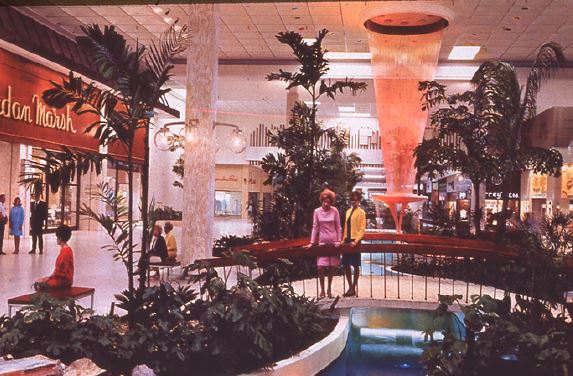
MODERN ECONOMY
Florida’s economy changed following World War II. Many types of industries have employed thousands of Florida residents, including tourism, agriculture, construction, real estate, and services. In recent years, the fields of aeronautics, computers, plastics, and medical research have been added to that roster.
Tourism provides nearly 1.5 million jobs in the state. Each year, popular tourist sites bring nearly fifty million visitors to Florida. Fun places such as Walt Disney World and other Orlando theme parks attract many vacationers. Cities like Miami Beach, St. Augustine, and Tampa also bring crowds. Do not forget the seemingly endless miles of beaches that attract vacationers. Tourists spend billions of dollars on shopping, entertainment, and outdoor activities.
The U.S. space program run by the National Aeronautics and Space Administration (NASA) operates at the Kennedy Space Center on Cape Canaveral. NASA has launched satellites and spacecraft, and sent space shuttles into space to do scientific research. The space program provides many jobs and adds nearly a billion dollars each year to the state economy.
The agricultural industry continues to earn money for Florida. Modern machines make planting, harvesting, and processing farm products quicker and easier. Florida’s agricultural products include citrus, cattle, dairy products, poultry, vegetables, and sugar cane. In this state, about one out of every six people works in agriculture.
PALM BEACH COUNTY TODAY AND IN THE FUTURE
Many cultures work and live in Palm Beach County, providing diversity that makes south Florida an exciting place. Everyone has the opportunity to learn from people of different backgrounds. Nearly every country in the world is represented in the schools of Palm Beach County. These students speak 135 languages.
What does the twenty-first century hold for Palm Beach County and Florida? According to statistics, 15,600 new residents moved to Palm Beach county in 2018. This growth stresses the county’s supply of natural resources—water, land, air, and wildlife—and government services, such as emergency services, health care, roads, government, and waste disposal.
When people move west, it puts stress on farmlands and what is left of the Everglades. Eventually, there will be no land on which to build. Development also ruins the natural habitats that provide homes for the variety of wildlife living in the county. In some cases, new construction erases the historical past of Palm Beach County. A greater demand for water is using up the fresh water supply that is already limited. More automobiles will continue to crowd the busy roads, leading to more construction of roadways and greater amounts of air pollution. Waste disposal becomes a huge concern. What do we do with all our trash? The next generation of voters will need to make educated decisions about these issues. These decisions will make a difference for future residents and visitors to Palm Beach County and Florida.
In the future, how will students view the county’s next hundred years of history? What will your role have been to preserve the environment and the history of Palm Beach County?
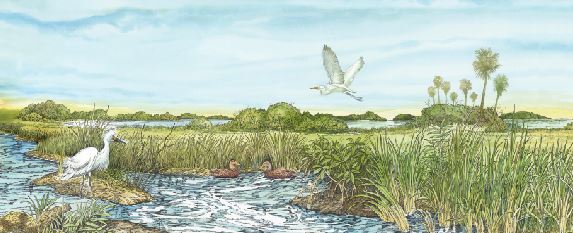
THE EVERGLADES
The distinctive Everglades is the largest subtropical wetland in North America. Formed between 5,000 and 6,000 years ago, it once covered over eight million acres, or much of south Florida reaching into present-day Palm Beach County. Before humans began draining the wetlands of south Florida, the Everglades was fed by water flowing south from the Kissimmee River into Lake Okeechobee. Water then overflowed the lake’s southern shore, creating a sheet of slow-moving water over low-lying land that slopes less than two inches per mile. The sheet of water continued moving southward for about a hundred miles, eventually emptying into Florida Bay, Ten Thousand Islands, and Biscayne Bay.
The Everglades is a combination of sawgrass marshes, cypress swamps, prairies, ponds, sloughs, pinelands, and forest hammocks. It is a balanced yet fragile ecosystem that includes mammals, a variety of birds, fish, reptiles including alligators and crocodiles, insects, microorganisms, and plants. The introduction of invasive species, like the python, is endangering the ecosystem.
In the late 1800s, man began draining the land for agriculture and for living space. Large-scale draining efforts in the following century seriously affected the Everglades and other wetlands, destroying at least 50% of them in south Florida. Because of the drainage, the water flow that is important to the Everglades has been interrupted. Water is now drained from Lake Okeechobee through the Caloosahatchee River and St. Lucie Canal systems, then south to Florida and Biscayne bays through a system of canals and water management areas.
As the once vast wetland shrank, the Everglades National Park was established to save what was left of it. It covers 1.5 million acres (20% of the original Everglades) in southwest Florida. President Harry Truman dedicated the park on December 6, 1947. In Palm Beach County, portions of the original Everglades still exist. Grassy Waters Preserve in West Palm Beach provides drinking water to the city and covers twenty-three square miles. West of Boynton Beach is the Arthur R. Marshall National Wildlife Management Area, which covers 221 square miles. The public can visit both of these parks.
- What is Florida’s rank in population in the U.S.?
- Where did the people of the Yamato Colony come from? What happened to them?
- Where is the largest Haitian population in the United States?
- What types of contributions have people of Jewish heritage made in Palm Beach County?
- List some of Florida’s modern industries.
- Who are the Fanjuls? Where are they from? What kind of business do they operate? What crops do they grow?
Using a world map, identify the countries that the different Hispanic groups are coming from.
What is the difference between the number of Jews in Palm Beach County in 1950 compared to 2018?
Write a fictional story about the Pioneer Era with either Lillie Pierce Voss or Susan Sanders DuBois as one of the main characters.
In 1981, the first personal computer was developed by IBM in Boca Raton.

